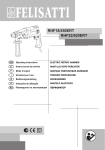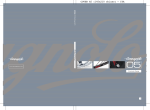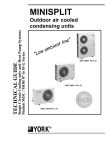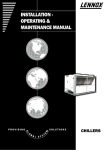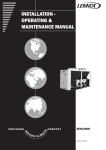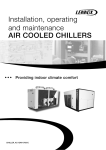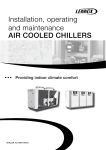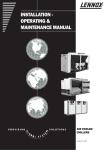Download York MOH 55 Owner`s manual
Transcript
INSTALLATION & OWNER'S MANUAL GUIDE MINISPLIT CONDENSING UNIT Models MOC-MOH 07-65 SAFETY Installation and maintenance of this air conditioning system should only be carried out by trained and qualified personnel. Regular maintenance operations such as cleaning the coils and air filters must be performed to keep the units in proper operating condition. CAUTION Before undertaking any work on the unit, make sure that the power supply has been disconnected. ELECTRICAL CONNECTIONS GENERAL PRECAUTIONS All electrical wiring and connections must comply with local standards. Power supply cord and interconnection cord used must not be lighter than Polychloroprene sheated cord (245 IEC 57 or H05RN-F). Disconnecting device must have a contact separation of at least 3 mm. Check that the power supply available agrees with nameplate voltage. Use adequate line protection. The unit must be grounded. CRANK CASE HEATER For units fitted with crankcase heater, the heater MUST be on for a minimum of 6 hours before starting compressor. Failure to observe this precaution may result in damage to the compressor or reversing valve. OUTDOOR UNITS The units are shipped complete with a charge of R22 / R-407C refrigerant sufficient for a piping length of 7.5 metres. Four vibration absorbing mounts are delivered with each unit as well as a drainage elbow connector for condensate drain connection (on heat pump models only). From size 25 upwards, outdoor units are fitted with transport handles to facilitate handling and placement. Every compressor is delivered with a sound-proofing wrap to reduce noise levels to a strict minimum. The unit support plate is shaped in such a way that water produced during defrost operations on heat pump units is collected at a single point where it can easily drained off. No accessory drain pan is required. TECHNICAL SPECIFICATIONS CONDENSING UNIT (MOC-MOH) - 50 Hz Models Power Supply Power Consumption Running Current Refrigerant Type Refrigerant Charge Compressor Dimension Weight Piping Pipe Size Outdoor Unit V/Ph/Hz Ph kW A gr Qty Compressor Type Height mm Width mm Depth mm kg Type Suction inch Liquid inch 07 09 12 18 1 0.817 3.77 1 0.957 4.42 1 1.257 5.92 1 1.82 8.42 620 / 650 900 / 1,000 920 / 1,050 1 1 1 Rotary 492 492 492 764 764 764 230 230 230 38 39 41 3/8 1/4 3/8 1/4 MOC-MOH 25 35 40 45 55 220-240/1/50 or 380-415/3/50 1 3 1 3 1 1 3 3 2.71 2.64 3.29 3.216 3.2 3.7 4.62 5.461 12.8 5.02 15.8 3.16 18.8 21.0 8.62 10.22 R-22 1,750 2,600 3,900 3,650 3,000 3,800 1 1 1 1 1 1 Reciprocating Scroll Reciprocating 696 900 1,142 1,142 1,142 1,142 850 850 1,060 1,060 850 1,060 287 285 345 345 285 345 70 92 103.5 122.5 90 129 Flare + Nuts 5/8 5/8 5/8 3/4 3/4 3/4 3/8 3/8 3/8 3/8 3/8 3/8 1,620 1 590 820 280 63 1/2 1/4 5/8 3/8 65 3 5.87 11.22 4,700 1 Scroll 1,142 1,060 345 134 3/4 3/8 CONDENSING UNIT (MOC-MOH) - 60 Hz Models Power Supply Power Consumption Running Current Refrigerant Type Refrigerant Charge Compressor Dimension Weight Piping Pipe Size Outdoor Unit V/Ph/Hz Ph kW A gr Qty Compressor Type Height mm Width mm Depth mm kg Type Suction inch Liquid inch 09 12 18 1 0.97 4.8 1 1.2 5.5 1 2.314 13.62 900/1,000 920/1,050 1 1 Rotary 492 492 764 764 230 230 39 41 3/8 1/4 1,650 1 590 820 280 63 1/2 1/4 5/8 3/8 07G 09G 12G 1 0.777 3.52 1 0.937 4.32 MOC-MOH 25 35 208-230/1/60 or 460/3/60 1 1 3 3.024 3.65 3.995 14.02 16.77 6.67 R-22 1,750 2,600 1 1 Reciprocating 696 900 850 850 287 285 70 92 Flare + Nuts 5/8 5/8 3/8 3/8 45 55 65 3 6.74 11.24 3 7.01 12.04 3,000 1 3,800 1 1,142 850 285 104 1,142 1,060 345 129 5,500 1 Scroll 1,142 1,060 345 134 3/4 3/8 3/4 3/8 3/4 3/8 3 5.618 8.7 CONDENSING UNIT (R407C) Models Power Supply Power Consumption Running Current Refrigerant Type Refrigerant Charge gr Qty Compressor Type Height mm Dimension Width mm mm Depth Weight kg Cooling kg Heating Type Piping Suction inch Pipe Size Liquid inch Compressor Outdoor Unit Outdoor Unit V/Ph/Hz Ph kW A 850/1000 1 720/1000 1 1 1.34 6.12 492 764 230 37 38 492 764 230 38 40 1150 1 Rotary 492 764 230 42 43 3/8 1/4 3/8 1/4 1/2 1/4 MOC-MOH 25G 35G 18G 220-240/1/50 or 380-415/3/50 1 1 1 3 2.658 3.729 3.489 1.77 12.42 18.47 7.07 8.12 R-407C 2100 3000/2500 3000/2500 1880 1 1 1 1 696 850 287 68 69 Flare + Nuts 5/8 5/8 3/8 3/8 590 820 280 62 63 45G 55G 3 4.868 9.48 3 5.168 13.94 900 1060 345 107 109 3000 1 Scroll 1142 1060 345 127 129 5/8 3/8 3/4 3/8 4000 1 1142 1060 345 127 129 3/4 3/8 DIMENSIONS OVERALL DIMENSIONS MOC/MOH 07-18 MOC/MOH 25-35 MOC/MOH 40-65 D W W D W D H H H Unit dimensions are shown in Technical Specification table. OUTDOOR UNIT CLEARANCES A minimum of clearance is necessary around the units to ensure proper air circulation and easy access for maintenance. MOC/MOH 07-18 MOC/MOH 25-35 MOC/MOH 40-65 A A A B D B D B D E E E C C MOC/MOH (mm) 07-18 25 35 40 45 55 65 A 400 200 200 200 200 200 200 B 200 400 400 400 400 400 400 C 100 100 100 100 100 100 100 D 600 210 210 300 210 300 300 E 190 600 800 800 800 800 800 NOTE To prevent ice build up beneath the unit during winter operation, it may be necessary to increase the dimension of C by 50 to 100 mm. Distances between mounting hole centres MOC/MOH L (cm) I (cm) 07-09-12 49.7 24.8 18 51.7 29.6 25-35-45 55 31.5 40-55-65 74 37.5 L I INSTALLATION Unit installation details: – unit mounting – refrigerant piping connections – condensate water drainage connections – unit wiring connection Whatever type of installation is chosen for the unit, the following installation rules must be observed: – The location selected for unit installation must be capable of withstanding the weight of the unit in its full operating configuration. – Select a location where neither dust nor other foreign bodies will clog the unit coil. – If the outdoor unit is installed on the ground, make sure that the location is not liable to flooding. – Make sure that you know and apply any and all local rules and regulations concerning the installation of air conditioning equipment. – Use the vibration isolators provided to prevent vibration transmission and resulting unnecessary noise. – Do not install the equipment in explosive environments. – Make sure that the surrounding atmosphere does not contain noxious or dangerous substances such as oil vapours or sulphur. – If the air conditioner is installed in a polluted area, increase the frequency of maintenance operations. – Avoid installing the unit where it will be in direct sunlight, especially if it is a cooling only model since direct sunlight will increase condensing pressure and reduce unit efficiency. Install units facing North whenever possible. – In particularly windy places, the unit should be installed so that the prevailing wind does not interfere with air discharge from the unit (configuration with the wind blowing onto the side of the unit). – MOH heat pump unit : install the unit at least 10 cm above ground level to facilitate drainage of defrost water and prevent accumulation of ice. In effect, defrost water can cause accumulation of ice under the unit during subfreezing outdoor temperatures. OK – Wherever possible, install the unit where it will be protected from rain, snow and runoff from overhanging structures. – In areas with heavy snowfall it is best to install the unit on wall supports. – If condensates are not to be drained, do not install the elbow supplied with the unit. – Make sure that the unit is installed level so that condensate will drain off correctly. – In some regions. It is necessary to heat the bottom of the condensate drainage pan and the condensate drainage piping to avoid ice formation, and resulting ice build-up in the fan compartment (heater strip must be at least 25 W/m). REFRIGERANT CIRCUIT CONNECTIONS Make piping runs as short as possible and avoid all unnecessary changes in direction or elevation. To prevent heat loss, the two lines must be insulated separately. Use an appropriate bending tool to form curves and avoid flattening the refrigerant tubes. Fix piping with pipe clamps and check that any eventual pipe vibrations cannot be transmitted to the building structure. Use refrigeration quality piping only with an operating pressure rating of at least 30 bars. Never use ordinary <<plumbing>> quality piping : you MUST use special deoxidized, dehydrated, refrigerant quality copper piping. – Evacuate the piping. This operation, which should last at least 15 minutes or even longer if there are large piping lengths and changes in elevation, should be followed by a leak test. – To this effect, when the piping has been evacuated, close the pressure gauge tap, note the value on the gauge, then wait for 15 minutes. If the needle moves, there is a leak in the system. Make the necessary adjustments or repairs and repeat this procedure until the needle no longer moves. – Open the service valves and top up the refrigerant charge if necessary. Insulation PIPE LENGTHS • Maximum piping lengths MOC-MOH 07 09 12 18 25 35 40 45 55 65 D(m) 12 12 15 15 22 22 26 26 26 26 L(m) 15 15 18 18 25 25 30 30 30 30 H(m) 10 10 12 12 20 20 24 24 24 24 Minimum thickness 6 mm Heat pump (discharge) L NOTE Heat pump Where the difference in elevation between the indoor unit and the outdoor unit is greater than 5 meters, install an oil trap every 5 meters. The suction line must have a 2% gradient up to the compressor on horizontal sections. Where piping lengths are unusually long and include a large number of oil traps, it may be necessary to adjust the compressor oil charge. Liquid D Cooling Heat pump (discharge) L Heat pump • Refrigerant charge to be added per extra meter of piping length when more than 7.5 m. Unit size 07 09 12 18 25 35 40 45 55 65 g/m 15 15 15 40 40 40 40 40 40 40 Cooling (suction) GAS Cooling (suction) Liquid H Cooling Refrigerant piping connections (FLARE connections) To avoid alteration of unit capacities, check that piping lengths and changes in elevation are kept to a strict minimum. Before connecting the refrigerant lines, follow the procedures below (if pre-charged connection lines are not supplied): – Select copper pipe diameters according to the size of unit to be installed. – Install the refrigeration lines, checking that no foreign bodies get inside the piping. – Install the flare connectors and flare the ends of the pipes. Low pressure High pressure Manifold Liquid valve Pressure tap Outdoor unit Gas line Gas valve Indoor unit Liquid line R22 / R-407C ELECTRICAL CONNECTIONS MOC 07 - 35 - Cooling only L 1 2 N 1 2 L Outdoor unit Power supply 220-240V/1Ph/50Hz 208-230V/1Ph/60Hz MOC 25 - 55 - Cooling only N L1 L 2 L3 1 N MOH 07 - 35 - Heat pump Indoor unit N 2 3 N 1 2 3 Outdoor unit MOH 25 - 55 - Heat pump N 2 1 1 Power supply 220-240V/1Ph/50Hz 208-230V/1Ph/60Hz Indoor unit L1 L 2 L3 2 1 2 N 1 Outdoor unit Power supply 380-415V/3Ph/50Hz 460V/3Ph/60Hz Power supply 380-415V/3Ph/50Hz 460V/3Ph/60Hz Wire sizes 07 09 12 MOC-MOH Power supply mm2 Ph 3x2.5 A 3x4 25 35 40 45 55 65 5x2.5 5x4 1 1 1 1 3 1 3 1 3 1 1 3 3 3 3x2.5 2 Interconnection Cooling mm (Indoor/Outdoor) Heating mm2 Fuse (slow-blow) 18 4x2.5 10 16 10 25 10 32 16 35 40 16 20 25 Indoor unit N Indoor unit 3 2 3 Outdoor unit Terminals N and 1 (see diagrams above) correspond to power supply to the indoor unit coming from the outdoor unit. Compressor power supply is established by terminal 2. Power supply to the 4-way valve is established by terminal 3. For further details on wiring of these units, see the diagrams pasted inside each unit. START-UP MOC 18 - MOH 18 Before starting the air conditioner, please check the following points: - That the unit is installed according to instructions given in this documentation. - That the unit is correctly wired up. - That flare connection nuts are tightened. Compressor - That the unit has been evacuated and leak-tested. - That isolating valves have been fully opened. - That the refrigerant charge has been topped-up if necessary. Start the units and check operation in both the cooling and the heating mode. Diagram n°1 Coil Unit base plate DEFROST Defrost is handled via a defrost management electronic control board (model with two potential meters and 6 dip switches, see diagram n°2). This enables defrost cycles to be initiated when the temperature reaches -5°C at the condenser coil bend. The end of defrost cycle set point is +10°C. The duration of the defrost cycle varies depending on operating conditions but it is limited to a maximum of 10 minutes. Time delay between successive defrost cycles is 30 minutes. The defrost cycle can be forced into action by shunting terminals DEF on the defrost control board in the outdoor unit. The time delay between successive defrost cycles and the maximum duration of each cycle are adjustable. If these need to modified, please contact YORK first for technical advice. If your unit does not defrost correctly, please check the follow points carefully: - Is the refrigerant charge correct ? - Is the sensor in the right location on the outdoor coil ? - Low and high pressure switch settings on units : MOC-MOH 35-45-55 LP = 1.5 Bars HP = 28 Bars 2 1 1 “Dip Switches” for adjusting time delay between defrost cycles and maximum defrost cycle duration. ON Transformer 1 2 3 4 5 6 2 Female sensor connection DEF 3 Diagram n°2 - Adjustable Defrost Control Board 3 Shunt these terminals to stimulate a defrost cycle. FAN SPEED CONTROLLER A fan speed controller is provided as standard on full featured condensing units and can be installed also as an accessory in the field on all N series condensing units that are equipped with a pressure tap (see diagram below) for easy installation. The Saginomiya pressure type controller (YORK P/N 025T20003-000) is recommended. Fan speed controllers should be added when the units are installed where operation in cool mode is required during periods with low outdoor ambient temperatures. Complete installation instructions are included with every fan speed controller kit ordered from the factory. 95 Slide Potentiometer 3 1 4 (CW) Increase the set valve 2 5 Indoor unit Decrease the set valve (CCW) 100 Outdoor unit 10 Caution 7 Cut Off Risk of electric shock 8 Min Speed 1 2 3 4 9 4- ø5.4 Capillary Tube Conduit Gland (900 mm Length) 1/4 Female Flare with Schrader Copper Packing PRESSURE TAP COOLING CIRCUIT - PRESSURE TAP LOCATION NO. 1. Parts Name Bellows 2. Wiper 3. Operating Plate 4. Range Adjusting Screw 5. Coil Spring 6. 7. Terminal Board Changeover Switch 8. Pressure Connector 9. Range Setting Pointer PHASE ROTATION Scroll compressors designed to operate only in one direction. If opposite direction is required, swamp any two phases at the main terminal block. Reciprocating compressors are able to run in either direction without any loss of performance or reliability. Special Note for units fitted with Scroll Compressors Phase sequencing: the Scroll compressor is designed to operate with motor running in only direction. Mis-wiring of phase power (phase reversal) will cause the compressor to operate in the wrong direction. The Scroll compressor will run without damaging itself if phasing is improper, but it will not pump refrigerant and will draw minimal current. In such a case, the internal winding line break will ultimately shut off the compressor. Depending upon the conditions it could take up to 30 minutes to trip the internal winding protection. The compressor will be noisy, vibrate excessively and the oil sump will become warm to hot when running backwards. Because of the scroll compressor design and its capability to accommodate liquid slugging, both oil and refrigerant, without causing compressor damage, there are some characteristic sounds that differentiate if from those normally associated with reciprocating type compressors. These sounds described below, are characteristics and do not affect reliability or indicate that the compressor is defective. At Start-up: Under conditions of low refrigerant flows (low suction pressures) such as start-up, a rating sound may emanate from the compressor. This is more like to be heard under conditions such as low ambient starts where it takes time to build sufficient head pressure to allow the thermal expansion valve to flow sufficient refrigerant to increase the suction pressure. This sound should diminish and disappear as the suction pressure increases. At Shutdown: The gas within the scroll expands and causes momentary reverse rotation until the discharge check valve seats. This results in a "flutter" type noise. Refrigerant Flooding: If the compressor experience severe liquid slugging during the operation the compressor will make a loud rattling sound. This is normal because of the separation of the scrolls that allow the liquid refrigerant to pass through the compressor without damaging it. TROUBLESHOOTING GUIDE Open the main unit power switch before proceeding with any repair operations. Symptoms Cause Remedy Symptoms No heating or cooling The compressor and outdoor fan do not operate The outdoor fans run but the compressor will not start Power failure Fuse blown or circuit breaker open Voltage is too low Faulty contactor, thermostat or relay Electrical connections loose Faulty capacitor (single phase models) Thermostat adjustment too low (in heating mode) or too high (in cooling mode) Incorrect wiring, terminals loose Contact the electrical utility company Replace the fuse or reset the breaker Find the cause and fix it Replace the faulty component Retighten the connections if necessary Find the cause, then replace capacitor Check thermostat setting Ice build-up indoor coil Check and retighten Faulty installation Pressure switch tripped (depending on mode) Find the cause, then reset Make sure vibration isolators have been installed. Check piping collars Compressor noisy Make sure that the compressor is not losing oil Excessive oil or refrigerant charge Motor windings cut or grounded Check the wiring and the compressor winding resistance Faulty capacitor (single phase models) Find the cause, then replace capacitor Remove charge, repair, evacuate and recharge insufficient airflow Check the air filter, the damper positions Check that air is not being recycled Check cleanliness of unit coils Capillaries obstructed or orifice plugged (humidity) Liquid and gas lines insulated together Clean or replace, set the air damper to the right position Clean the coils Remove charge, repair, evacuate and recharge Insulate them separately Tighten any loose components Repair and add oil Repair or replace the thermostat Thermostat Thermostat incorrectly adjusted Readjust the thermostat Remove excess charge Safety device Check continuity through fuse Safety thermostat opens Replace faulty elements Check indoor unit airflow Check cleanliness of air filter and coil Open air balancing dampers If ducts are long, inhibit low, and perhaps even medium fan speeds Check that wiring complies with applicable diagrams Faulty unit wiring Change the setting Excessive or insufficient discharge pressure Check condenser air circulation Find leak, repair and recharge Reduce load or use next unit size up Remove charge, evacuate and recharge Excessive discharge pressure Out door coil dirty Indoor unit fan (heating mode) or outdoor unit fan (cooling mode) faulty Excessive refrigerant charge Air or incondensables in refrigerant circuit Clean the coil Replace the fan Insufficient discharge pressure Refrigerant charge too low Find and repair the leak, top up refrigerant charge Find obstructions and eliminate them Replace the compressor Unit short-cycles Too much or too little refrigerant Air or incondensibles in refrigerant circuit Faulty compressor Power supply voltage too high or too low Faulty condenser (single phase models) Faulty thermostat Restriction in the refrigeration circuit Frostec or plugged expansion device Poor airflow on indoor or outdoor unit Repair the leak and recharge Check the condition of the air filters Check the cleanliness of the indoor coil Check fan motor operation Check that the air damper opens correctly (on unit equipped with a damper) Install a low temperature kit Unit noisy The Compressor runs too long or continuously The compressor starts but shuts down quickly on thermal protection Remedy Electric heat does not work (on indoor units fitted with this option) Make sure there are no leaks Thermostat adjustment too high (in heating mode) or too low (in cooling mode) No fan operation or faulty fan Reffrigerant charge too low, leakage Heating/cooling load underestimated Air or incondensables in refrigerant circuit Low refrigerant charge, refrigerant leak Insufficient airflow Low operating temperature limit exceeded Insufficient heating or cooling Low refrigerant charge The compressor runs continuously Cause Frosted Indoor coil Remove charge, evacuate and recharge Remove charge, evacuate and recharge Determine the cause and replace compressor Solve the problem Determine the cause and replace Replace Find restriction and repair Remove charge, evacuate and recharge Clean the coil and the filter if necessary, check that motors are operating properly Faulty power supply Check wire gauges, etc Changeover valve damaged or blocked open Replace it (heat pump units) Liquid line blocked or crushed Compressor valves worn out or leaking Remove excess charge Check the circuit, evacuate, and recharge Excessive or insufficient suction pressure Excessive suction pressure Refrigerant overcharge Cycle changeover valve faulty or leaking (heat pump units) Remove excess refrigerant Replace the valve Insufficient suction pressure Low refrigerant charge Outdoor unit coil (heating mode) or indoor unit coil (cooling mode frosted) Insufficient airflow on the outdoor unit coil (heating mode) or the indoor unit coil (cooling mode) Suction line obstructed Expansion device obstructed or iced up Poor contact the line and the defrost sensor in the heating mode (heat pump units) Condenser airflow too high (in the cooling mode) in relation to outdoor air temperature Add some refrigerant Find cause and fix it Make sure that the indoor or outdoor unit fan is operation properly Find obstruction and eliminate Remove charge, evacuate, recharge Reinstall the sensor correctly using a contact compound. Insulate the assembly Install a low temperature kit TECHNICAL APPENDIX Cooling circuit diagrams Outdoor unit Outdoor unit Indoor unit Indoor unit 7 9 5 5 6 6 1 1 4 2 4 2 8 8 6 6 5 3 5 3 10 Cooling only - MOC 07-09-12-18-25 Legend: 1. Compressor 2. Outdoor unit coil 3. Capillary tube 4. Indoor unit coil 5. Refrigerant circuit piping Heat pump - MOH 07-09-12-18-25 Outdoor unit Outdoor unit 6. Isolating valve with pressure tap 7. High pressure switch (intermediate season safety) 8. Anti-slugging receiver 9. 4-way cycle changeover valve 10. Non-return valve Indoor unit Indoor unit 5 5 3 6 2 3 8 4 4 1 1 6 5 10 10 10 Heat pump - MOH 07-09-12-18-25 Cooling only - MOC 35-40-45-55-65 Legend: 1. Compressor 2. Outdoor unit coil 3. Combined HP/LP pressure switch (manual reset for the HP switch) 4. Indoor unit coil 5. Refrigerant circuit piping 6. Isolating valve with pressure tap 7. HP pressure switch (Interseason start-up safety) 8. 4-way cycle changeover valve 9. Anti-slugging receiver 10. Restrictor Unit Capacity Total cooling capacity can be determined by using correction factors C1, C2 and C3. Given cooling capacity = Cooling capacity at standard rating conditions x C1 x C2 x C3. C1 = Capacity correction factor for temperature C2 = Capacity correction factor for piping length C3 = Capacity correction factor for indoor unit fan speed Capacity correction factor for temperature (C1) Capacity correction factor for piping length (C2) Cooling Capacity correction factor for Indoor Temperature ϒC WB Indoor unit Indoor Temperature ϒC DB Piping length (m) 19 25 30 35 40 23 - 1.20 1.15 1.11 1.06 1 19 1.10 1.08 1.04 1 0.96 0.90 14 0.88 0.86 0.84 0.82 0.79 0.74 46 Correction factor C2 10 1.00 0.98 Capacity correction factor for indoor unit fan speed (C3) Indoor unit Fan speed Correction factor C3 Heating Capacity correction factor for 5 High Medium Low 1 0.90 0.75 Operating temperature limits Indoor Temperature ϒC WB Indoor Temperature ϒC WB 14 10 6 0 -8 23 1.20 1.04 0.96 0.77 0.58 21 1.25 1.10 1 0.80 0.69 17 1.30 1.13 1.04 0.83 0.63 Cooling mode Heating mode Maximum Minimum + 46ϒC + 19ϒC (-5 with low ambient kit) + 28ϒC (heat pump mode) - 8ϒC Correction factors (C1) determine the instantaneous capacity (which does not take account of defrosting on heat pump units). These capacities may vary slightly, depending on the size of the unit. MINISPLIT UNIT START-UP CHECK-LIST Contractor Equipment reference numbers Location: Indoor unit Outdoor unit Order/invoice number: Type Type Installation start-up date: Serial Number Serial Number Power supply and unit 3 Ph1-2= V A Neutral Earth interconnection cables Ph/N= Single phase V Ph2-3= V A yes yes with corresponding currents Ph= A Ph3-1= V A no no Power supply cable Gauge= mm2 Length= m Interconnection cable Gauge= mm2 Length= m Type of line protection Type Current= A Check that all electrical connections are light and that the unit is property earthed Refrigeration piping Ø liquid= in. l. liquid= m Ø gas= in. l. gas= m Position of indoor unit Height of the unit= m Height of the room= m Dif. in elevation between units indoor > outdoor m ext > int m Changes in direction Number of oil traps= Condensate pump Pumping height= Condensate drainage U-Bend Number of bends= yes m Type of drainage= no Ø drainage piping= cm Check that you have: Evaporator Return air temperature= °C Air discharge temp.= °C Condenser Inlet air temperature= °C Outlet air temp.= °C Temperature measurements Superheat= °C Sub-cooling= Low temperature kit yes Fan rotation correct (direction) °C no yes no Suction pressure LP at low speed= Bar LP at high speed= Bar Discharge pressure HP at low speed= Bar HP at high speed= Bar Compressor Amps l at low speed= A l at high speed= A Control thermostat cut out (open)= °C cut out (closed)= °C Low pressure switch trip= Bar reset= High pressure switch trip= Bar reset= Refrigerant charge top-up yes / quality= Oil top-up yes / quality= Checked unit charge g g yes Bar Bar no no no Completely opened the isolating valves. Insulated the gas and liquid lines separately. Tightened all flare connections. Leak-tested the entire installation. Evacuated the refrigeration circuit. Tested all functions of the air conditioner in the heating and the cooling mode. Tested the crankcase heater for correct operation. Installed the units in accordance with all instructions given in the documentation. Name, address and phone number of your contractor: DECLARATION OF CONFORMITY Type o Equipment Brand Name York Type Designation Manufacturer Application of Council Directive(s) DE - COMMISSIONING DISMANTLING & DISPOSAL Air Conditioners MHH/C07-35, MAH/C18-66, MCH/C09-55, MI12-35, MKH/C25-55 MOH/C07-65, HHH, HHW, HHY, HAW, HAY, HIW, HIY, HCH, HCW, HCY, MMH/C York Industrial Thailand Co., Ltd. Laemchabang Industrial Estate, Export Processing Zone 2, 49/40 Moo 5, Tambon Tungsukla, Amphur Sriracha, Chonburi 20230, Thailand. Tel : (66-38) 493-400 Fax : (66-38) 493-421-4 Low Voltage Directive 73/23/EEC, EMC Directive 89/336/EEC, and CE Marking Directive 93/68/EEC This product contains refrigerant under pressure, rotating parts, and electrical connections which may be a danger and cause injury! All work must only be carried out by competent persons using suitable protective clothing and safety precautions. Read the Manual Risk of electric shock Unit is remotely controlled and may start without warning The following harmonized standards have been applied: Standard(s) Test report(s) Issued by Date(s) EN 60 335-2-40:97 EN 60 335-1:94, A11, A1, A12, A13, A14 EN55014-1 (1993) and Amendment A1(1997) EN60555-3 (1987) and Amendment A1(1991) EN61000-3-2 (1995) EN5014-2(1997) 0038222 0038222 0043237D, E 0043237D, E 0043237D, E 0043237D SEMKO SEMKO SEMKO SEMKO SEMKO SEMKO 2001-02-22 2001-02-22 2001-10-28 2000-10-28 2000-10-28 2000-10-28 The product complies with the harmonized European safety standards and harmonized EMC standards listed above. 1. Isolate all sources of electrical supply to the unit including any control system supplies switched by the unit. Ensure that all points of electrical and gas isolation are secured in the OFF position. The supply cables and gas pipework may then be disconnected and removed. For points of connection refer to unit installation instructions. 2. Remove all refrigerant from each system of the unit into a suitable container using a refrigerant reclaim or recovery unit. This refrigerant may then be reused, if appropriate, or returned to the manufacturer for disposal. Under No circumstances should refrigerant be vented to atmosphere. Where appropriate, drain the refrigerant oil from each system into a suitable container and dispose of according to local laws and regulations governing disposal of oily wastes. 3. Packaged unit can generally be removed in one piece after disconnection as above. Any fixing down bolts should be removed and then unit lifted from position using the points provided and equipment of adequate lifting capacity. Reference MUST be made to the unit installation instructions for unit weight and correct methods of lifting. Note that any residual or spilt refrigerant oil should be mopped up and disposed of as described above. 4. After removal from position the unit parts may be disposed of according to local laws and regulations. We have internal production control system that ensures compliance between the manufacturer products and the technical documentation. The product is CE mark in 2001 We declare under our sole responsibility that the equipment follows the provisions of the Directives stated above. 2001-3-05 York Industrial Thailand Co., Ltd. Laemchabang Industrial Estate, Export Processing Zone 2, 49/40 Moo 5, Tambon Tungsukla, Amphur Sriracha, Chonburi 20230, Thailand. Tel : (66-38) 493-400 Fax : (66-38) 493-421-4 YORK® International Corporation Graham Joyce Technical Director 035T83112-000













